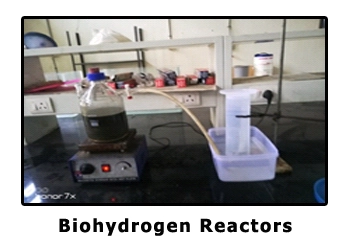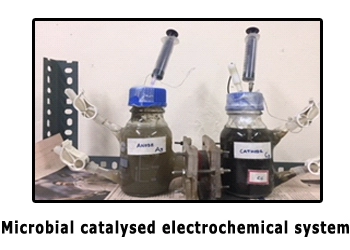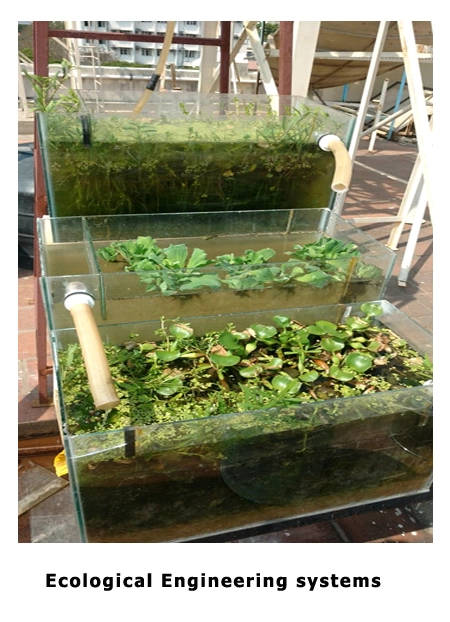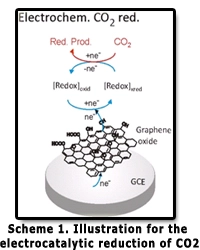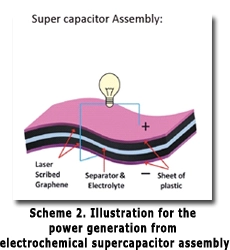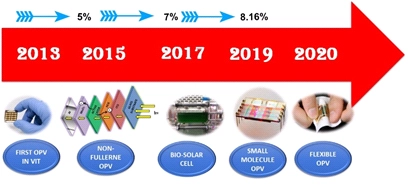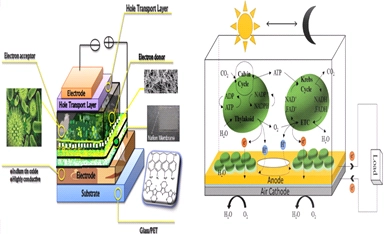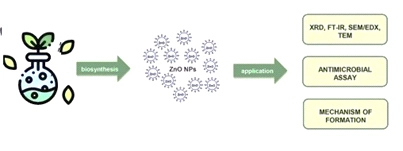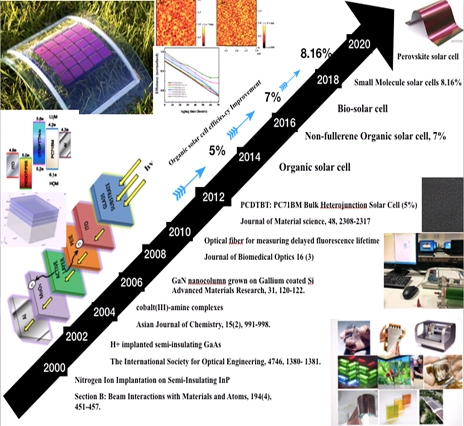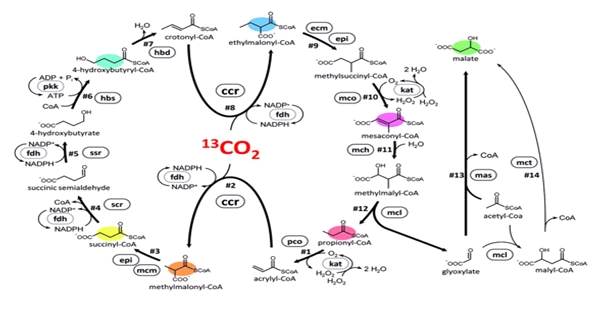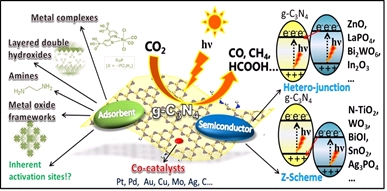CO2 Research and Green Technologies Centre
Projects
- Completed Research Projects
- Ongoing Research Projects
| S. NO | PROJECT TITLE | FUNDING AGENCY | PERIOD | FUNDING AMOUNT (RS IN LAKH) | PRINCIPAL INVESTIGATOR |
|---|---|---|---|---|---|
| 1 | Solar Dish Stirling Engine | Ministry of New and Renewable Energy (MNRE) | 2002 | 80 | Dr. R. Natarajan |
| 2 | Biomass based power plant using down draft gasifier | Ministry of New and Renewable Energy (MNRE) | 2002 | 35.72 | Dr. R. Natarajan |
| 3 | Storage and production of hydrogen using metal hydride – water system | TIFAC – DST | 2004 | 4.5 | Dr. R. Natarajan |
| 4 | Development of technology for upgradation of producer gas from biomass gasifier as feedstock in solid oxide fuel cell for power generation | Department of Science and Technology (DST) | 2006-2010 | 37.52 | Dr. R. Natarajan |
| 5 | Experimentation and CFD analysis of a 10kW circulating fluidized bed biomass gasifier | Department of Science and Technology (DST) | 2007-2010 | 24.18 | Dr. R. Sundaresan |
| 6 | Production of biogas and generation of power using sludge from waste water treatment plant | Ministry of New and Renewable Energy (MNRE) | 2010-2011 | 40 | Dr. R. Natarajan |
| 7 | Pyrolysis of waste agro biomass by thermo-catalytic process using microwave in pebble/fluidized bed reactor | Ministry of New and Renewable Energy (MNRE) | 2010-2012 | 117 | Dr. R. Natarajan |
| 8 | Installation of 100% producer gas engine using the gas from biomass gasifier | Ministry of New and Renewable Energy (MNRE) | 2012-2015 | 25.01 | Dr. R. Natarajan |
| 9 | Development of tri-generation (power, cooling and desalination) plant by compressed air humidification and dehumidification | Council of Scientific and Industrial Research (CSIR) | 2013-2015 | 19.28 | Dr. T. Srinivas |
| 10 | Development and Installation of Micro Thruster augmented Wind power Generator using a 200kW MICON Power Plant at C-WET facility, Kayathar | Ministry of New and Renewable Energy (MNRE) | 2014-2016 | 91.96 | Dr. R. Natarajan |
| 11 | Carbon Sequestration and Enzymatic Transesterification of Microalgae Lipid into Bio-diesel using lipase Immobilized on Magnetic Nanoparticles | Department of Biotechnology (Biocare Scheme – Early career women scientist | 2014-2017 | 14 | Dr. S. Vijayalakshmi |
| 12 | Experimental study on Kalina Cycle Cogeneration System | Science and Engineering Research Board (SERB) | 2015-2017 | 34 | Dr. T. Srinivas |
| 13 | Morphology engineering of high performance organic solar cells: A comparative study based on spin and spray coating methods | DST-YSS | 2015-2018 | 24.56 | Dr. K.Santhakumar |
| 14 | Theoretical investigations and modeling of a double-screw hydrogen extruder. | BOARD OF RESEARCH IN NUCLEAR SCIENCES | 2016-2019 | 23.68 | Dr. Senthil Kumar Arumugam |
| 15 | “Investigation of tandem device engineering, interface properties and stability of bulk heterojunction solar cells for high performance | CSIR | 2016-2019 | 5.82 | Dr. K.Santhakumar |
| 16 | Molecular docking and synthesis of peptide based antihelmintic drugs | Indian Council of Medical Research | 2017-2020 | 24.24 | Dr. J. Ranjitha |
| 17 | Characterization and structure based inhibitor discovery of mycobacterium smegmatis dehydroquinate synthase | Indian Council of Medical Research | 2017-2020 | 26.9 | Dr.S.Vijayalakshmi |
| 18 | Co Pyrolysis of Agro-biomass with plastic waste for bio oil production in a tubular reactor: Performance and emission characteristics of the bio oil blends in diesel engine | SERB under ECR scheme | 2017-2020 | 39.24 | Dr. S. Murugavelh |
| 19 | Development of Stable and Redox Active Inorganic/Organic Functionalized Carbon Nanotube Modified Electrodes: In-sight Studies using Scanning Electrochemical Microscope and Electro-catalytic/Bio-letrocatalytic Applications | DST-SERB | 2017-2020 | 59.7 | Dr. Senthil Kumar Annamalai |
| S. NO | PROJECT TITLE | FUNDING AGENCY | PERIOD | FUNDING AMOUNT (RS IN LAKH) | PRINCIPAL INVESTIGATOR |
|---|---|---|---|---|---|
| 1 | Development of electrochemical immuno sensor based detection method for white spot syndrome virus (WSSV) of penaeid shrimp | Ministry of Science & Technology, DBT | 2018-2021 | 30.69 | Dr. Senthil Kumar Annamalai (CO-PI) |
| 2 | Bioconversion of CO2 to Biofuels through Microbial Catalyzed Systems | Department of Biotechnology | 2020-2023 | 49.97 | Dr. G. Velvizhi |
| 3 | Harnessing the potential of renewable energy (Solar/Wind) for sustainable building energy management through Compressed Air Energy Storage | Department of Science & Technology | 2020-2023 | 135.61 | Dr. V. Gayathri |
| 4 | CO2 Sequestration to Biopolymers through Bioelectrochemical Systems using Enriched Microbiome | DST, SERB Power Grant | 2021-2024 | 29.44 | Dr. G. Velvizhi |
| 5 | Development of Direct Injection Technology for Hydrogen Enriched CNG and Biogas for Automobile and Stationary Power Applications | DST, Waste to Energy Scheme | 2021-2024 | 142.00 | Dr. Senthil Kumar Arumugam (Co-PI) Dr. S. Murugavelh (Co-PI) |
| 6 | A novel method of on-board hydrogen generation by methanol steam reforming with engine heat recovery strategy for direct injection of hydrogen in a CNG fuelled automotive SI Engine | DST-SERB (CRG) | 2021-2024 | 36.63 | Dr. Senthil Kumar Arumugam (Co-PI) |
| 7 | In-Situ Electrochemical oxidation of ¶-Self-Assemble Polyaromatic Hydrocarbons to Redox Active Intermediates on Graphitic Materials Surfaces:- Mechanism and Multipurpose Green-Technology Applications Perspectives. | DST-SERB (CRG) | 2021-2024 | 35.37 | Dr. Senthil Kumar Annamalai |
| 8 | Development of Rapid and High Sensitivity Electrochemical Covid-19 Diagnosis Platform | ICMR | 2021-2024 | 49.50 | Dr. Senthil Kumar Annamalai |
| 9 | Biomass driven trigeneration system for improving the livelihood of Scheduled Tribes at Athanavur village, Yelagiri Hills, Tamil Nadu” under STI Hub from DST | DST | 2021-2024 | 108.12 | Dr. G. Praveen Kumar (CO – PI) |
Theoretical investigations and modelling of a double screw hydrogen extruder
A closely intermeshing counter rotating twin-screw extruder is used to produce solid hydrogen filament at 11 K which is further pelletized to fuel the tokamak. A 3-dimensional CFD modeling has been successfully developed to study the extrusion process due to positive displacement action of the screws and predict the performance of the extruder. The shear rate dependent shear stress of solid hydrogen is modeled using Herschel-Bulkley equation. A systematic parametric analysis was carried out to arrive at an optimum design of the extruder to produce the hydrogen filament at a required throughput and specified size
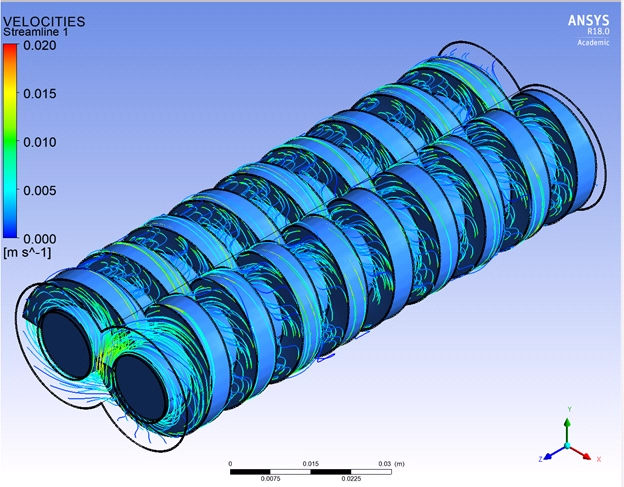
Co-pyrolysis of biomass and waste plastic for bio oil production
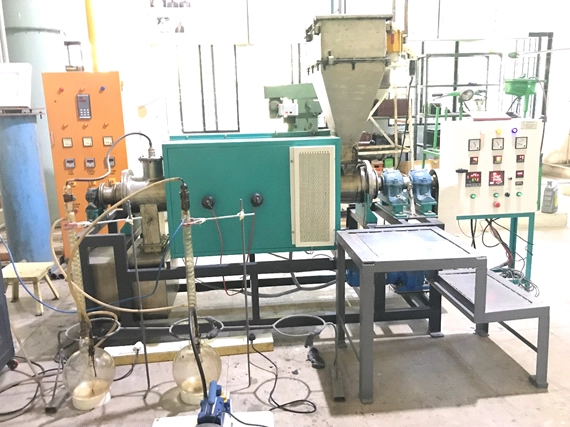
The objective of the project is to convert waste biomass and plastic waste into liquid fuel through pyrolysis. The hydrocarbon present in the plastics which is non-biodegradable can be utilized as an energy source. Thermochemical conversion of the biomass and plastic into liquid fuel helps in effective handling of the waste and also for energy generation. Co-pyrolysis of plastic and biomass improves the yield and quality of biooil. Addition of the plastic waste has resulted in improvement of the quality of the liquid fuel The calorific value of the biooil obtained from the pyrolysis of agro biomass is 17 MJ/kg whereas that of the copyrolysis oil is 29 MJ/kg. Also, copyrolysis has resulted in improvement in the kinematic viscosity of the oil. Testing of the obtained bio-oil in a CI engine has shown very promising results in terms of performance and emission. The biochar obtained from the pyrolysis of the agro biomass is a potential adsorbent and a charge carrier. It can be used for treatment of organic pollutants and wastewater from textile industries.
Biological Sequestration of CO2
Biological sequestration of CO2 could potentially make a significant contribution to Carbon capture technology as they can be deployed in a sustainable, renewable and eco-friendly manner. Research is been carried out on CO2 sequestration to value-added products and biofuels using Microbial catalysed electrochemical systems (MCES) and Gas Fermentation process (GF). Microbial catalysed electrochemical system synthesis CO2 to Acetate, Methane, Ethanol, Butanol etc through a series of bioelectrochemical reactions by using specifically enriched mixed bacteria in a fuel cell setup. Gas fermentation is an effective technology which ferments gases like carbon dioxide (CO2) carbon monoxide (CO), Hydrogen (H2), methane (CH4) etc to useful products using specifically enriched microorganisms. These approaches have been garnering new attention globally and could be a good solution for the industries aiming to valorize their carbon-rich gaseous emissions.
Solid waste Management
Municipal solid waste management (MSWM) is one of the major environmental problems and handling the waste is the challenging task. It is been estimated that India currently produces 62 million tonnes of MSW annually and expected to increase likely to 165 MT by 2030. Disposing this waste as such is huge problem, however utilizing this waste and converting them to value added products gives us bigger benefits. The primary focus of research is been under the theme “Waste to Wealth” and “Clean Energy”. Studies is been carried out to convert municipal solid waste to biohydrogen using acidogenic processes.
Ecological Engineering systems -Lakes Restoration
Water pollution is one of the major issue, most of the mini river, lakes, seasonal water stream and major rivers flows through the Indian cities are very badly polluted. This effects sanitation and causes public health. Hence restoring lakes is an important task which should be taken care. Research is been carried out to design an ecological engineering systems (EES) which could mimic natural ecosystem in an systematic manner to integrate floating, submerged and emergent macrophytes. The designed EES is ecologically complex, mechanically simple, consumes low energy, requires no chemicals, easy to operate, inexpensive to construct and moreover enhances aesthetic value by stimulating the natural cleansing mechanism in a sustainable way. This research could also resolve the problems of waster scarcity.
Prof Annamalai Senthil Kumar group has been working on various interdisciplinary areas of electrochemical science and technology researches, especially utilization of CO2 to useful products. Followings are the representative on-going works:
1. Electrochemical Reduction of CO2 to value added products:
Recent times electrochemical methods have gained substantial attention in environmental and energy technology related areas owing to its simple instrumentation and green technological approach. Amongst all, electrochemical reduction of carbon dioxide to useful products like methanol, syngas (H2+CO), methane, formaldehyde etc and development of energy storage systems like super-capacitors are particular interest. Our group has been working on development of electro-catalytic (chemically modified electrode) systems, in which redox active molecule immobilized carbon nanomatrix, for the CO2 reduction reaction (Scheme 1). Our prim aim is preparation, characterization and technological applications of these systems.
2. Electrochemical Supercapacitor and Hydrogen production system.
Storing electrical energy in an electrochemical double-layer capacitors (EDLC) based on charge separation at the interface is an attractive research. Electrochemical Super-capacitor has higher specific power than that of batteries and hence it is combined with batteries in the dual power electric vehicles. In addition the super capacitor provides longer service life, wider temperature range and fast charge-discharge features. In this context, our group has been working on low cost carbon based materials in combination of redox active mediators for the development of electrochemical pseudo-capacitor systems (Scheme 2). In another case, ultra-low cost disposable type of carbon screen-printed electrodes (after some pre-treatment) has been used for the production of hydrogen gas from dilute acid medium.
3. Low cost technologies for electrochemical production of hydrogen.
In recent days, in consideration with green-technology and zero-emission power generation system, development of economical way of electrocatalyst for the hydrogen gas evolution reaction (HER) is a challenging research. Although Pt and Au based systems showed efficient electrocatalytic activity (Eonset ~0.01 V vs Ag/AgCl; Tafel slope ~70 mV dec-1) with respect to its high cost and scarcity, limited attention has been shown on this catalyst now. Our group has been working on pre-treated-carbon-based electro-catalytic systems for efficient electrochemical reduction of water to hydrogen. Disposable type screen-printed electrode has been involved in this work.
Dr. K. Santhakumar - Energy harvesting Devices, Organic Solar cell, Bio-energy Production Techniques, Perovskite solar cells Phytochemistry
1. A cost effective renewable energy solution for future
a. Energy harvesting Devices, Organic, Hybrid and Perovskite solar cells
– New material design and synthesis
– Earth Abundant, Non-toxic & Manufacturing Friendly
– Lightweight power for portable electronics
– Solution process for roll to roll manufacture
– Tunable transparency, color, flexibility and
– Morphology Manipulation
– Versatile application
b. Bio-solar cell
– Breakthrough technology in replicating earth natural system because it only needs sunlight, water and CO2 to generate electrical energy.
– Self sustainable scalable and stackable design
– Improved device performance through bio-analyte strains.
– Better charge transport through inbuilt biological fuel cell incorporating air bubble chamber
2. Phytochemistry
– We Employ multidisciplinary technique in phytochemistry, molecular biology, biochemistry and tissue culture to understand how the production of plant natural products is controlled. – Synthesis of nanoparticles, Isolation, purification and identification of secondary metabolites. – Elucidation of pathways leading to formation of naturally occurring medicinal compounds in plants
Carbon Sequestration:
Microbial CO2 sequestration is a promising strategy to reduce global warming and optimize production of chemical substances. Microbial CO2 sequestration not only provides a green and sustainable approach for ameliorating global warming but also simultaneously produces biofuels and chemicals. Strategies including engineering CO2 fixing pathways and energy-harvesting systems have been developed to improve the efficiency of CO2 fixation in autotrophic and heterotrophic microorganisms. The biological CO2 sequestration has significant advantage, since increasing atmospheric CO2 level supports productivity and overall storage of the natural systems.
Photocatalytic reduction of CO2 into value added products:
The photocatalytic reduction of CO2 into value-added chemicals is a promising approach to promote energy-bearing products, mitigating the adverse effects of anthropogenic CO2 emissions. Our centre has been working on photocatalytic CO2 reduction into useful products like methane, methanol, formic acid, ethanol, acetaldehyde, etc. A series of hydrocarbon derivatives were successfully synthesized and characterized using different types of novel photo catalysts. Experimental and statistical optimization study of the synthesized photocatalytic compounds is in progress.
SCFE based Bioactive Elicitation and its industrial applications:
SCFE is usually performed with carbon dioxide, which facilitates off-line collection of extracts and on-line coupling with other analytical methods. Our Centre has been working on supercritical fluid CO2 based extraction of bioactive compounds from different agro biomass and its various industrial applications. Our aim is to elucidate the different bioactive compounds from different agro biomass and its various industrial applications. The research work is in progress.



